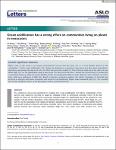Ocean acidification has a strong effect on communities living on plastic in mesocosms
| dc.contributor.author | Zhang, X | |
| dc.contributor.author | Zhang, P | |
| dc.contributor.author | Deng, Z | |
| dc.contributor.author | Huang, R | |
| dc.contributor.author | Zhang, D | |
| dc.contributor.author | Tian, Y | |
| dc.contributor.author | Wang, N | |
| dc.contributor.author | Li, H | |
| dc.contributor.author | Wang, X | |
| dc.contributor.author | Jiang, X | |
| dc.contributor.author | Sun, J | |
| dc.contributor.author | Fu, Q | |
| dc.contributor.author | Yi, X | |
| dc.contributor.author | Qu, L | |
| dc.contributor.author | Zhou, C | |
| dc.contributor.author | Rao, Y | |
| dc.contributor.author | Zeng, X | |
| dc.contributor.author | Hall‐Spencer, JM | |
| dc.contributor.author | Gao, G | |
| dc.contributor.author | Gao, K | |
| dc.contributor.author | Lin, X | |
| dc.date.accessioned | 2023-08-24T15:08:00Z | |
| dc.date.available | 2023-08-24T15:08:00Z | |
| dc.date.issued | 2023-08 | |
| dc.identifier.issn | 2378-2242 | |
| dc.identifier.issn | 2378-2242 | |
| dc.identifier.uri | https://pearl.plymouth.ac.uk/handle/10026.1/21261 | |
| dc.description.abstract |
We conducted a mesocosm experiment to examine how ocean acidification (OA) affects communities of prokaryotes and eukaryotes growing on single-use drinking bottles in subtropical eutrophic waters of the East China Sea. Based on 16S rDNA gene sequencing, simulated high CO2 significantly altered the prokaryotic community, with the relative abundance of the phylum Planctomycetota increasing by 49%. Under high CO2, prokaryotes in the plastisphere had enhanced nitrogen dissimilation and ureolysis, raising the possibility that OA may modify nutrient cycling in subtropical eutrophic waters. The relative abundance of pathogenic and animal parasite bacteria also increased under simulated high CO2. Our results show that elevated CO2 levels significantly affected several animal taxa based on 18S rDNA gene sequencing. For example, Mayorella amoebae were highly resistant, whereas Labyrinthula were sensitive to OA. Thus, OA may alter plastisphere food chains in subtropical eutrophic waters. | |
| dc.format.extent | 675-684 | |
| dc.language | en | |
| dc.publisher | Wiley | |
| dc.subject | 14 Life Below Water | |
| dc.title | Ocean acidification has a strong effect on communities living on plastic in mesocosms | |
| dc.type | journal-article | |
| dc.type | Letter | |
| dc.type | Journal | |
| plymouth.author-url | https://www.webofscience.com/api/gateway?GWVersion=2&SrcApp=PARTNER_APP&SrcAuth=LinksAMR&KeyUT=WOS:000975636500001&DestLinkType=FullRecord&DestApp=ALL_WOS&UsrCustomerID=11bb513d99f797142bcfeffcc58ea008 | |
| plymouth.issue | 4 | |
| plymouth.volume | 8 | |
| plymouth.publication-status | Published | |
| plymouth.journal | Limnology and Oceanography Letters | |
| dc.identifier.doi | 10.1002/lol2.10329 | |
| plymouth.organisational-group | |Plymouth | |
| plymouth.organisational-group | |Plymouth|Research Groups | |
| plymouth.organisational-group | |Plymouth|PRIMaRE Publications | |
| plymouth.organisational-group | |Plymouth|Faculty of Science and Engineering | |
| plymouth.organisational-group | |Plymouth|Faculty of Science and Engineering|School of Biological and Marine Sciences | |
| plymouth.organisational-group | |Plymouth|Research Groups|Marine Institute | |
| plymouth.organisational-group | |Plymouth|REF 2021 Researchers by UoA | |
| plymouth.organisational-group | |Plymouth|Users by role | |
| plymouth.organisational-group | |Plymouth|Users by role|Academics | |
| plymouth.organisational-group | |Plymouth|REF 2021 Researchers by UoA|UoA07 Earth Systems and Environmental Sciences | |
| dcterms.dateAccepted | 2023-04-10 | |
| dc.date.updated | 2023-08-24T15:07:38Z | |
| dc.rights.embargodate | 2023-8-26 | |
| dc.identifier.eissn | 2378-2242 | |
| dc.rights.embargoperiod | forever | |
| rioxxterms.versionofrecord | 10.1002/lol2.10329 |


